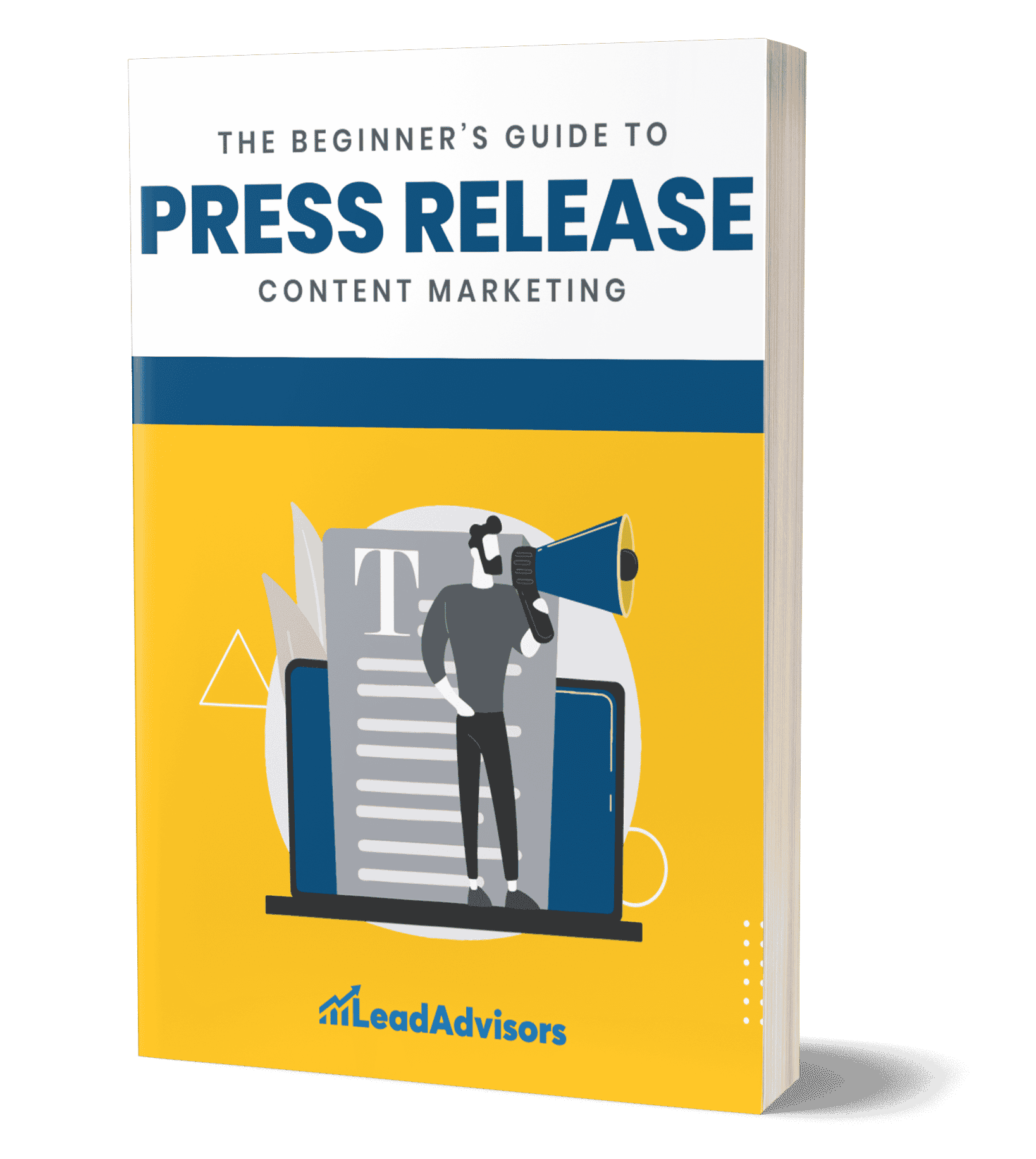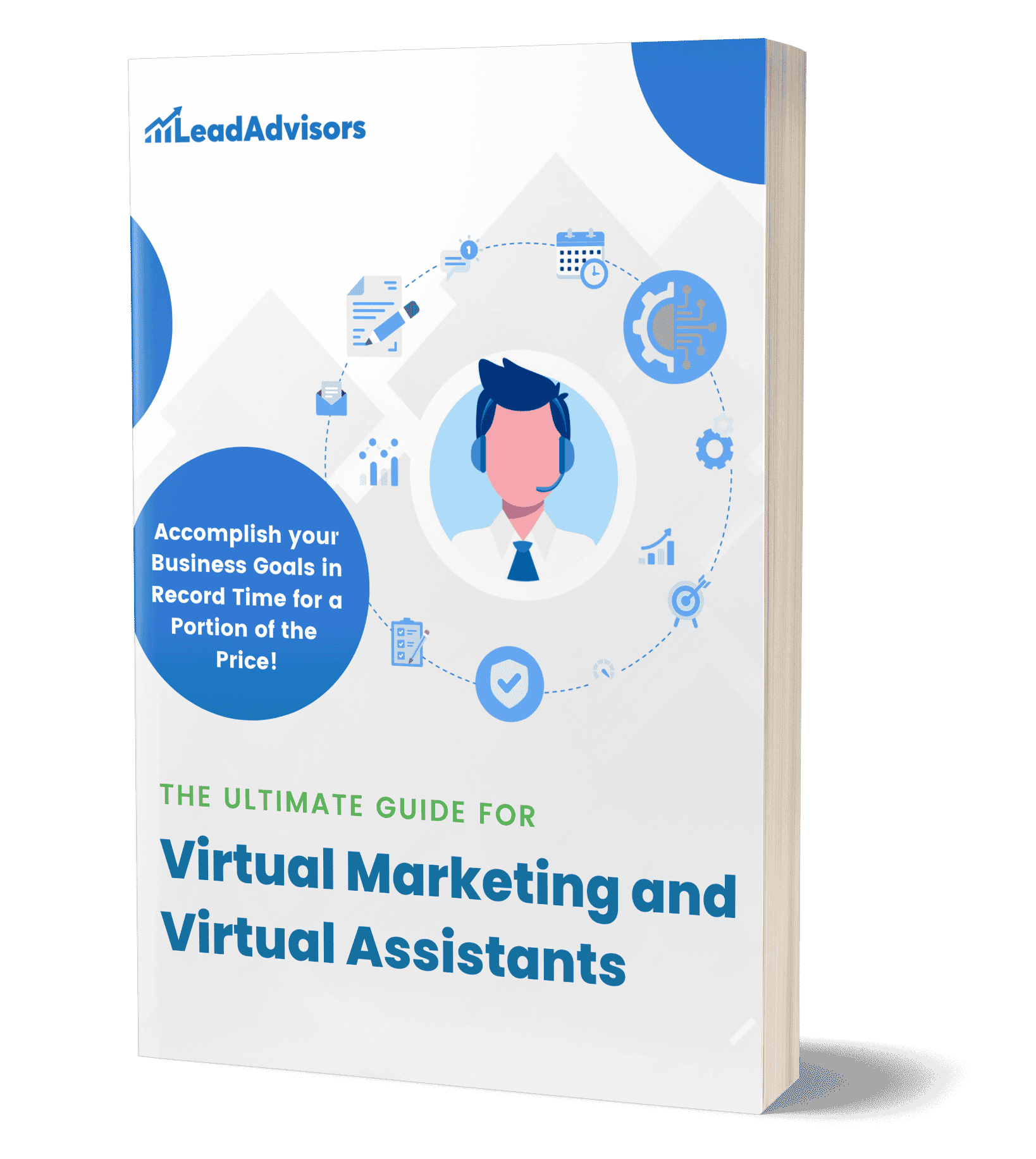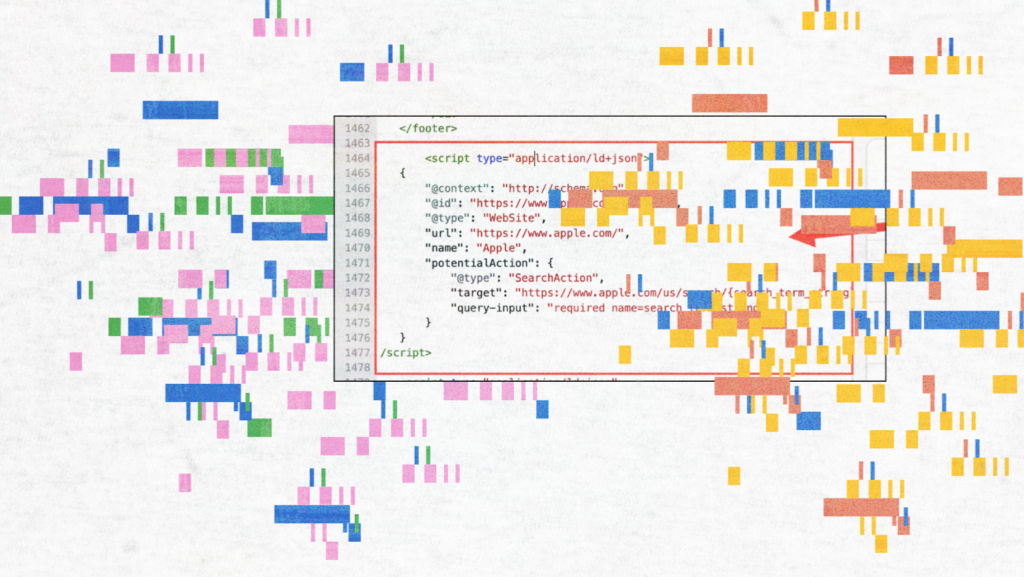“You never get a second chance to make a first impression,” they say. And if there’s one place where this rings true, it’s in customer service.
Just imagine – when someone approaches your support team, they expect a quick, clean fix. They don’t want the runaround or be told to call back. They want answers now.
That’s when First Call Resolution, or FCR, enters the picture.
In simple terms, FCR means resolving the customer’s issue during their very first interaction – no follow-ups, no call-backs, no “let me escalate this and get back to you.” Just straight-up problem-solving, in one shot.
Why does this matter? Because FCR is one of the most precise indicators of how effective (and efficient) your call center management support team really is. When customers get their problems solved the first time, they’re more likely to trust your brand, stay loyal, and even tell their friends how excellent your service is. Strong call center management practices lay the foundation for achieving consistent first call resolution.
On the flip side, if a customer has to contact you two or three times just to get the same issue resolved… oof. That’s not only frustrating – it’s a surefire route to negative reviews and lost business.
So get serious about First Call Resolution; it’s the first step towards better customer service.
What Is First Call Resolution?
Now before we dive deeper into how to measure or improve it, let’s clear up one common source of confusion: FCR isn’t always used the same way everywhere. You might hear terms like First Contact Resolution, One Call Resolution, or just Call Resolution thrown around like they all mean the same thing – but trust me, they don’t.
- First-call resolution usually involves resolving a customer’s issue in the first phone call to support. It’s tailored to voice-driven interaction.
- First Contact Resolution broadens the definition to include any first touchpoint—whether that’s chat, email, social media, or a phone call.
- Then there’s Call Resolution or One Call Resolution, which are often used interchangeably with FCR, but they don’t always factor in follow-up interactions that happen through other channels.
Why does this matter? Because if you are committed to tracking your first call resolution rate, you need to be consistent with your definitions. If there’s a lack of clarity here, it messes with your data, confuses your agents, and gives you a false sense of your team’s performance.
Think of it this way: If you don’t define what counts as a “resolved” call – or what counts as a “first call” – how can you tell if you’re actually improving? The first step to mastering first call resolution FCR is making sure everyone on your team is speaking the same language.
Why First Call Resolution Matters
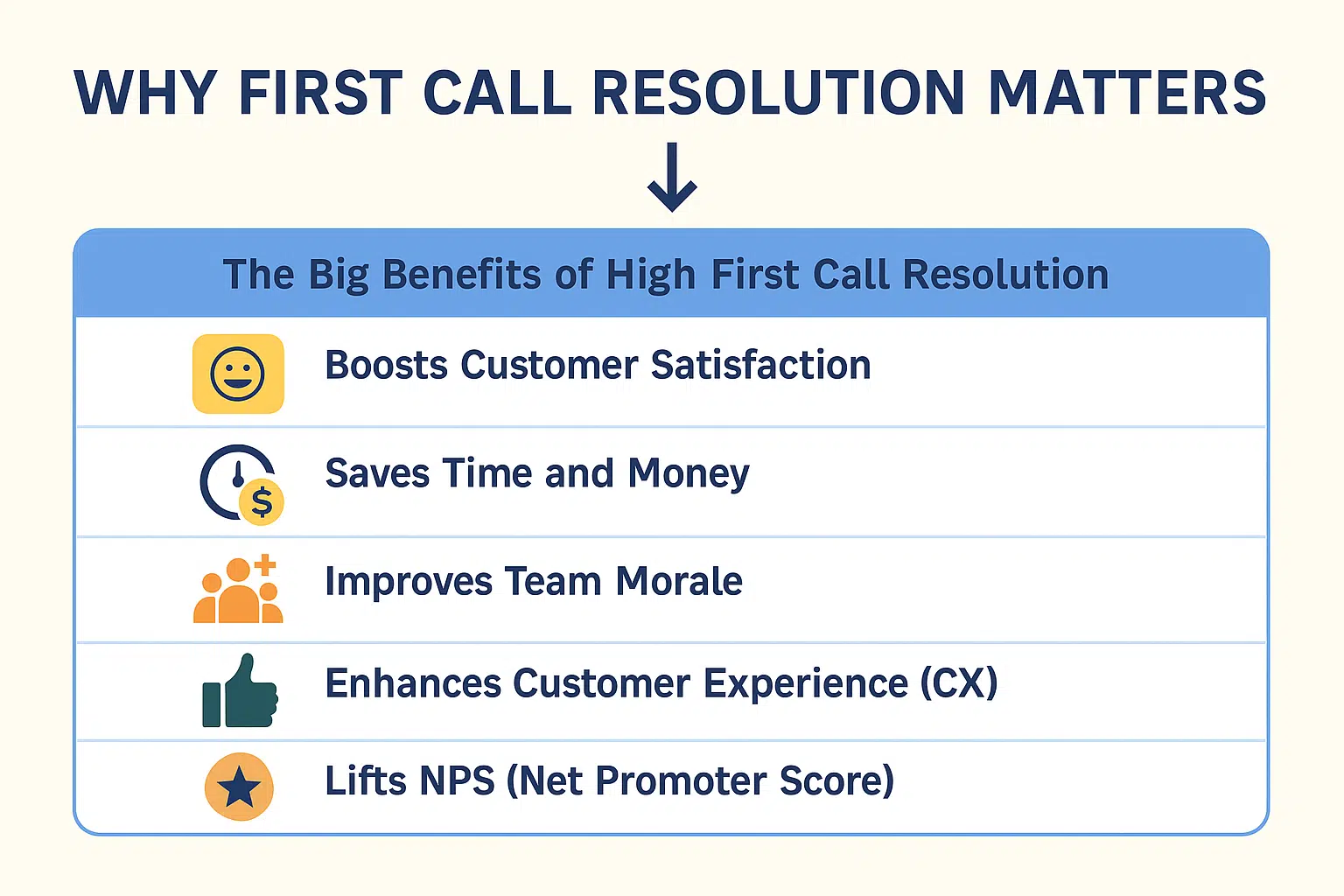
When your customer service team members get it right on the first try, it’s a total win – not just for your customers, but for your business and your team.
Here’s why First Call Resolution (FCR) isn’t just a “nice-to-have,” but a must-track metric:
The Big Benefits of High First Call Resolution
- Boosts Customer Satisfaction
Customers love it when they don’t have to call back or chase down answers. A higher first-call resolution rate usually means higher customer satisfaction. - Saves Time and Money
Fewer repeat calls = fewer resources needed. That means cost savings for your support team and more efficient staffing. - Improves Team Morale
When your customer service team members can resolve issues on the first try, they feel more confident and less burned out. - Enhances Customer Experience (CX)
First call resolution is a leading indicator of overall customer experience—the smoother the resolution, the better your CX. - Lifts NPS (Net Promoter Score)
Customers who get their problems resolved quickly are more likely to recommend your brand to others.
First Call Resolution in Action
| Contact Resolution Metric | Low FCR | High FCR |
| Customer Satisfaction | Decreases – customers are frustrated | Increases – customers feel heard and valued |
| Cost to Serve | Higher – more repeat calls to handle | Lower – fewer contacts per customer issue |
| Agent Experience | Burnout from repetitive issues | Motivated team with fewer repeat tickets |
| Customer Experience (CX) | Disjointed and annoying | Smooth, efficient, and memorable |
| Customer Relationship Health | Weakened trust over time | Stronger brand loyalty and retention |
So if you’re serious about leveling up your customer relationship management efforts, focus on improving your first call resolution (FCR). It pays off in happier customers, a more efficient team, and a brand that people actually love interacting with.
How to Measure FCR
So, we’ve talked about what first call resolution is and why it’s important – but how do you actually measure it?
Let’s break it down so your call center or contact center isn’t just guessing when it comes to performance.
The FCR Formula
Here’s the basic formula most teams use:
FCR Rate = (Total Customer Calls Resolved on First Contact / Total Number of First Customer Calls) x 100
This gives you a percentage – your first call resolution rate – which tells you how many issues were solved the first time compared to total customer calls.
Example:
If you had 700 calls resolved on the first contact out of 1,000 total first calls, your FCR rate would be 70%.
Internal vs. External FCR Tracking
There are two main ways to track First Call Resolution:
| Method | How It Works | Pros | Cons |
| Internal Tracking | System flags when no repeat customer calls come in within X days | Easy to automate in CRM or ticket system | May miss repeat contacts on other channels |
| External Tracking | Post-call surveys asking customers if their issue was resolved | Reflects true customer experience | Lower response rates; more manual effort |
Many businesses use both for a more complete picture.
Common Questions When Defining FCR
When you start tracking FCR, make sure your entire customer service team agrees on these key questions:
- Who gets to decide if the issue was resolved?
- The customer (ideal)?
- The agent (biased)?
- Or the organization/system (based on CRM data)?
- Do repeat contacts via a different channel count?
- Example: If a customer calls, and then chats about the same issue, does that count against FCR? (Hint: It should.)
- What’s your time window?
- Most businesses define FCR using a 1 to 30-day window. If a repeat customer call happens within that time, it’s usually counted as a failure to resolve.
Bonus Metrics to Watch
Sometimes your first call resolution rate can look decent on paper – but still hide red flags like poor customer service. These two supporting metrics help:
- Reopen Rate – How often customers reopen the same ticket or issue.
- Call Transfer Rate – High transfer rates can mean the first agent didn’t have the tools or training to resolve the issue.
Keep an eye on these to make sure your FCR is actually delivering value—not just hitting numbers.
Measuring FCR accurately gives you the power to reduce poor customer service, boost customer retention, and turn your call center into a well-oiled machine.
Want help turning these insights into a killer training or dashboard for your team? Or ready for the next section on how to improve FCR?
What Is a Good FCR Rate?
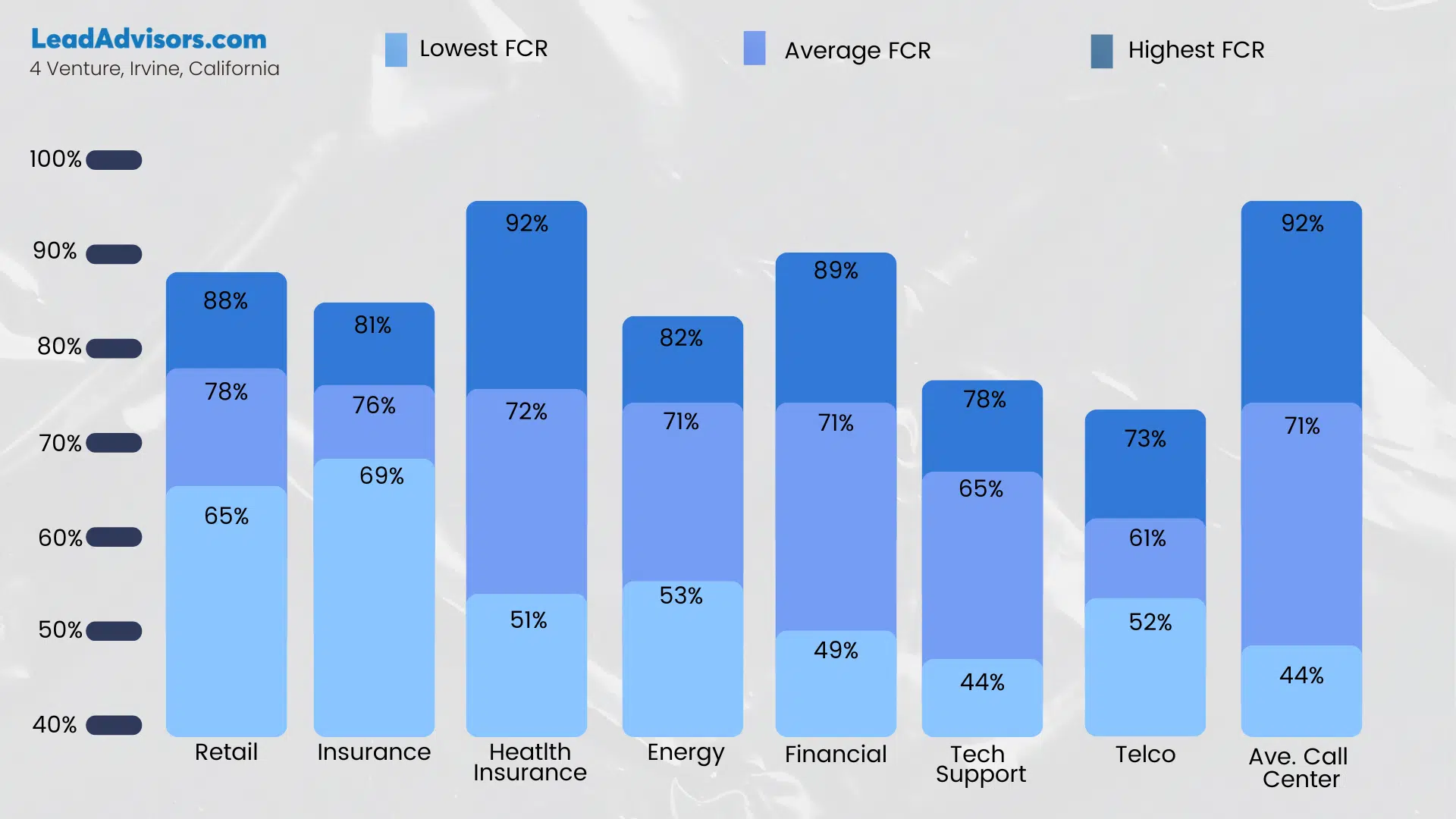
So, now that you know how to calculate first call resolution, you’re probably wondering… what’s considered “good.”
Well, that depends because FCR isn’t a one-size-fits-all metric. Your FCR rate can vary depending on the complexity of your support issues, your industry, your communication channels, and even the tools your team uses (look at you, outdated contact center software.
General Benchmark for FCR Rates
According to SQM Group, the average FCR rate across industries hovers between 70% and 75%. But here’s how it breaks down by sector:
| Industry | Average FCR Rate |
| Financial Services | 72–75% |
| Telecom / Cable | 65–70% |
| Healthcare | 68–73% |
| Utilities / Energy | 74–78% |
| Retail / E-commerce | 70–75% |
Aim for 75%+ if you’re delivering straightforward support. If you’re dealing with complex billing issues or compliance-heavy industries, anything above 65% is still solid.
What Affects FCR Rates?
Several factors can drag down or lift up your FCR rate:
- Call Complexity
Tougher problems take longer to resolve. Issues involving multiple departments or approvals naturally lower your FCR. - Channel Mix
If your support happens across chat, email, social media, and your customer service portal, tracking “first contact” resolution can get tricky. A quick phone call might be easier to solve than a multi-threaded email. - Staffing and Training
If your team is stretched thin or lacks proper onboarding, even the simplest issues can bounce between agents—hurting your FCR. - Outdated Tools
Without integrated contact center software, agents may lack visibility into the entire customer journey, leading to repeated questions and disconnected customer interactions.
In short: A “good” FCR rate is relative, but the best teams don’t just hit numbers. They focus on providing smarter, faster resolutions across every step of the customer journey, whether that’s through a live rep, chatbot, or customer service portal.
Key Challenges in Achieving High FCR
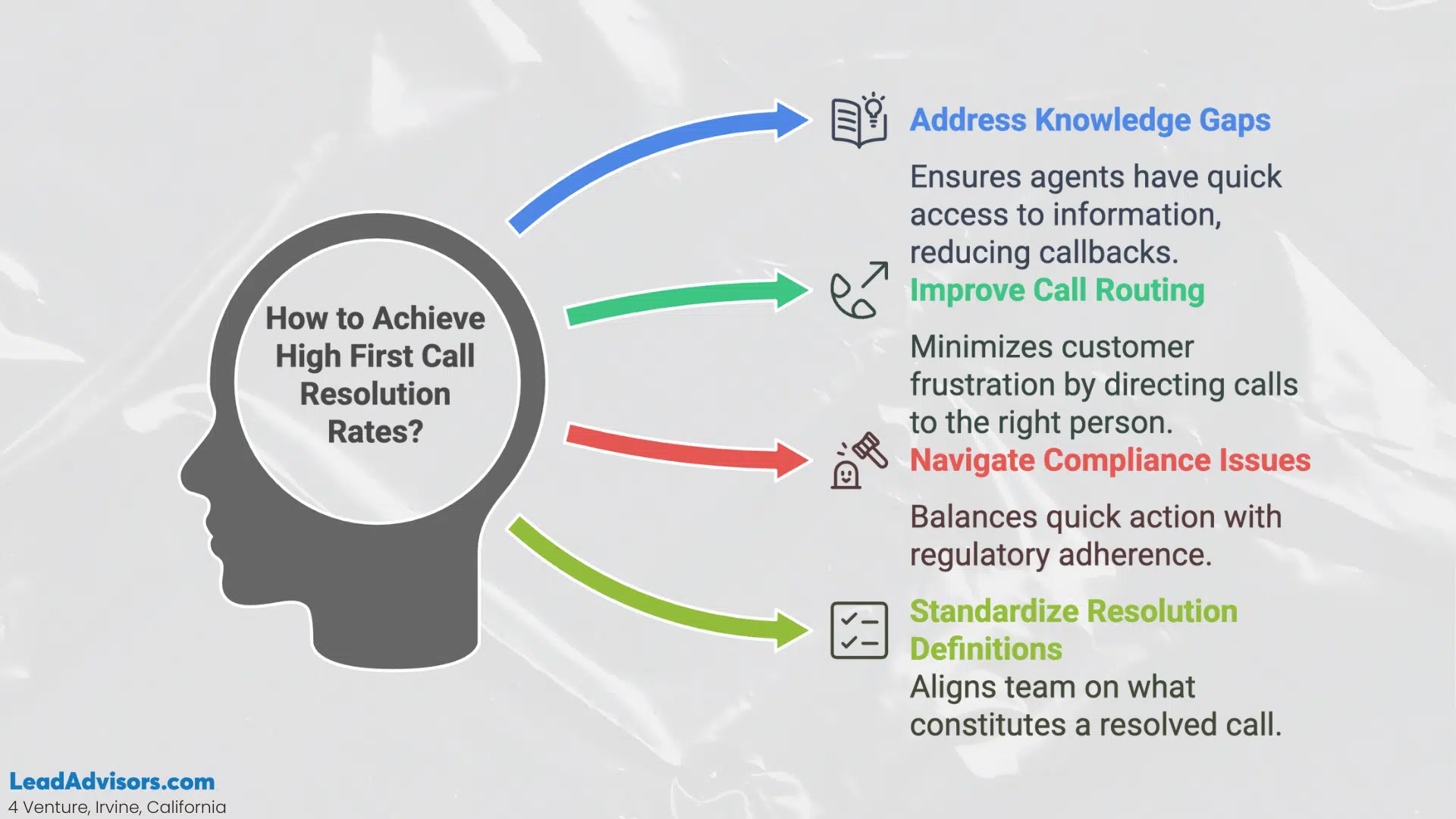
Let’s be real—improving your first call resolution rate isn’t just about telling agents to “try harder.” There are deeper, structural issues that can quietly sabotage your efforts if you’re not careful.
Here are some of the most common blockers that hold teams back from hitting high FCR rates:
What Gets in the Way?
- Agent Knowledge Gaps
When reps don’t have quick access to product details or past customer interactions, it’s hard to resolve anything in one go. Confusion leads to callbacks, which is an instant FCR hit. - Poor Call Routing
Transferring customers to the wrong person or department adds frustration and time. Even worse, it makes your support feel disorganized. - Compliance and Policy Blockers
Sometimes the right answer is buried under red tape. Especially in regulated industries, strict policies can limit how quickly agents can act—even if they want to help. - Inconsistent Definitions of “Resolution”
If your team isn’t aligned on what counts as “resolved,” your FCR rate won’t reflect reality. It’s like playing a game with different rules at every desk. - Lack of Visibility into Why Calls Fail
If you’re not getting post-call feedback or tracking call patterns, how do you even know what’s going wrong? You can’t fix what you can’t see.
How QAcall Helps
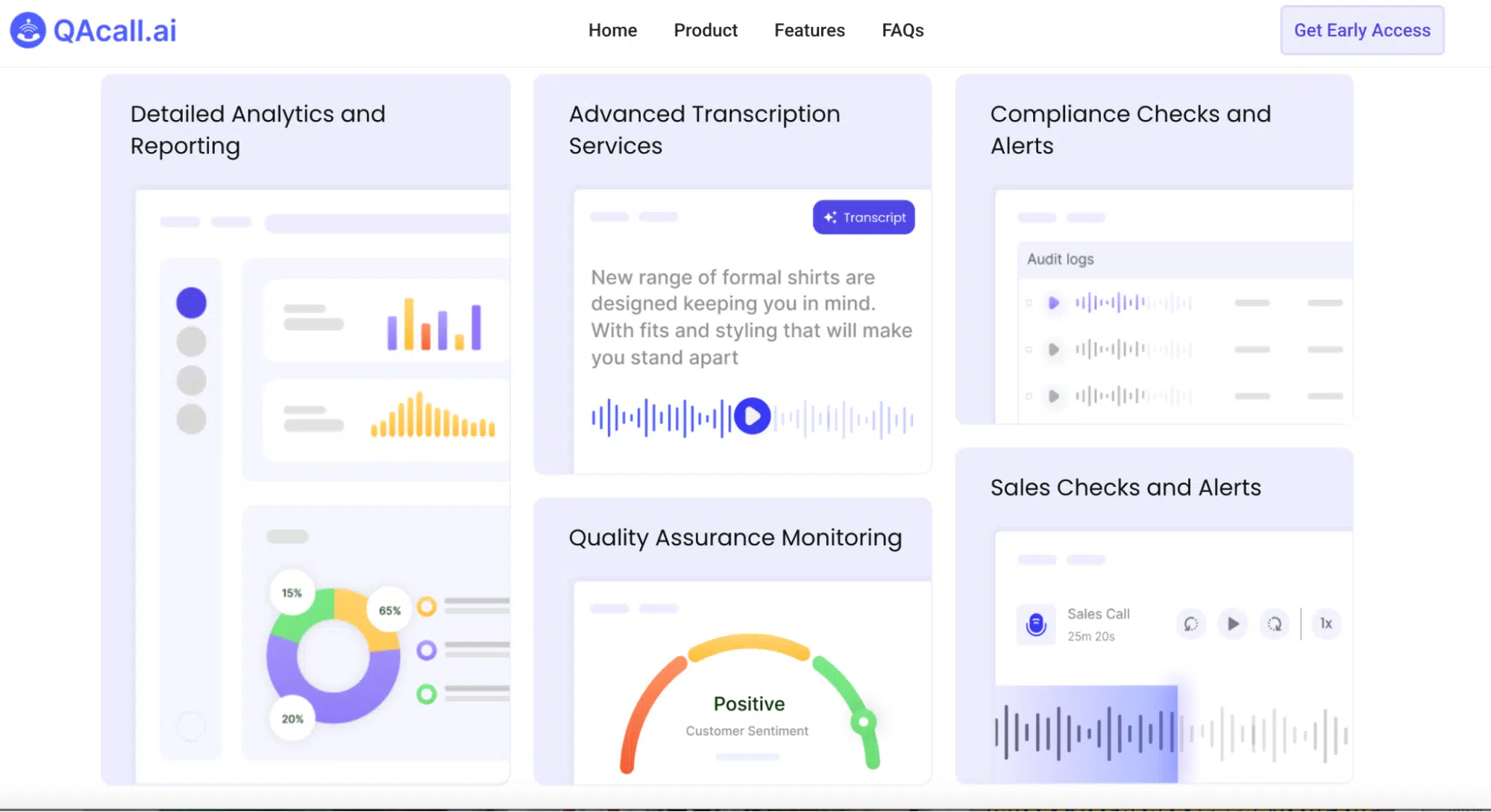
That’s where a smart tool like QAcall.ai comes in. Instead of relying on guesswork, QAcall gives your team real visibility into every part of the resolution process.
It integrates right into your contact center software and helps solve multiple FCR challenges at once by offering:
- Real-time call transcription to track what was actually said
- Sentiment analysis to flag frustrated or unsatisfied callers
- Custom compliance scoring to ensure policies aren’t missed
- Performance dashboards to pinpoint patterns and coaching moments
So when an agent struggles with a certain call type—or when policies are getting in the way of resolution—you’ll know, and you’ll be able to act fast. No more guessing. No more vague “bad call” notes. Just clear, actionable insights.
With QAcall in place, your team isn’t just answering calls – they’re resolving them better, faster, and with fewer repeats. That’s how you boost FCR and deliver a smoother customer experience from start to finish.
Best Practices to Boost First Call Resolution
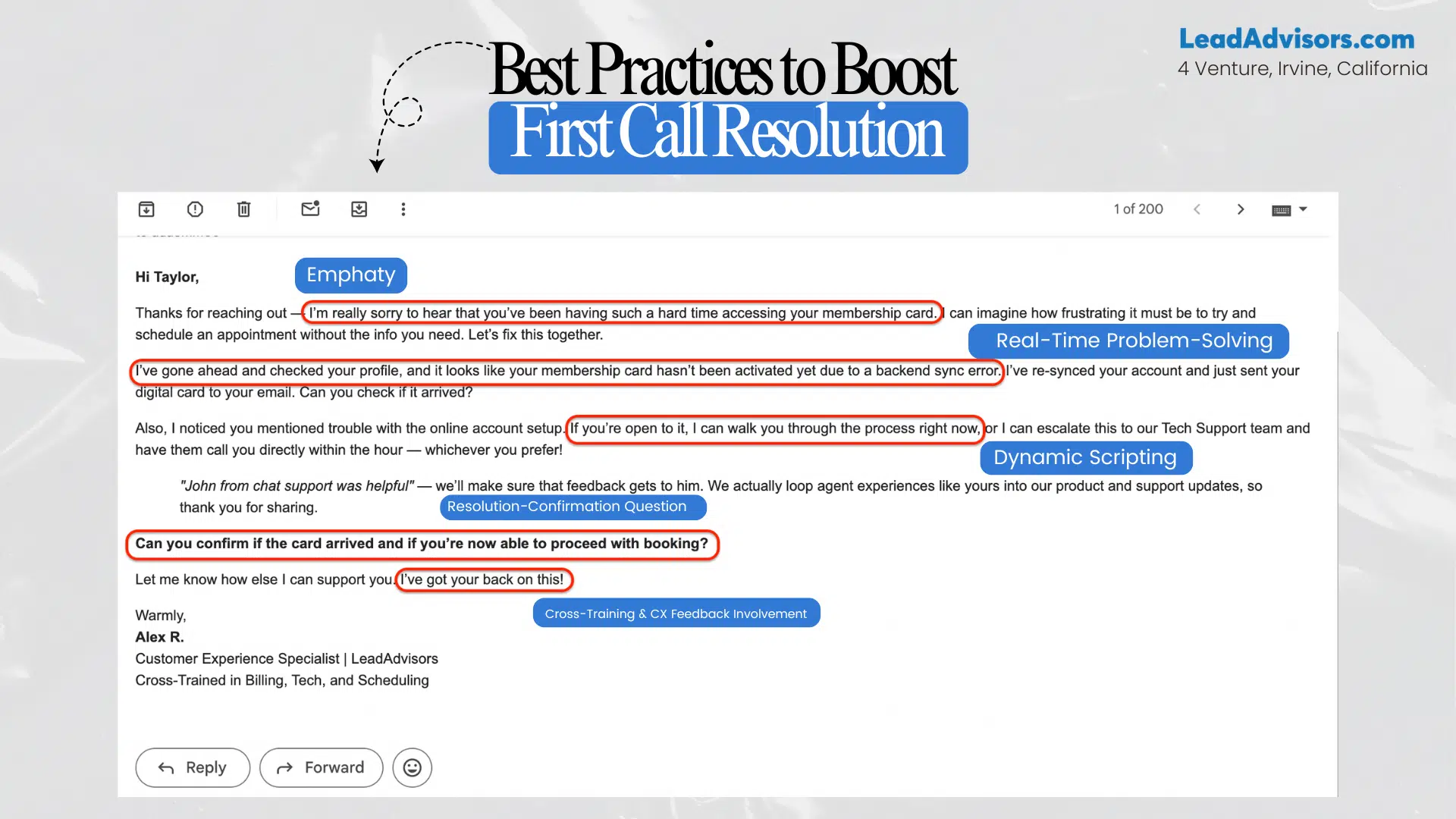
Your first call resolution rate isn’t just a metric, it’s a reflection of how well your team, your systems, and your tools work together. Let’s break down how to boost it from all angles.
Agent-Level: Equip the People Behind the Call
| Tactic | Why It Works |
| Train for empathy + real-time problem-solving | Builds trust and helps agents respond flexibly in unpredictable scenarios |
| Use dynamic scripts | Ensures critical info is covered without sounding robotic |
| Ask resolution-confirmation questions | Catches unresolved issues before the customer hangs up |
| Cross-train across departments | Reduces call transfers and boosts first-contact effectiveness |
| Involve agents in CX feedback loops | Helps them see the bigger picture and feel connected to the customer journey |
Organizational-Level: Get Your House in Order
- Gamify FCR targets and reward quality
Celebrate agents who resolve calls thoughtfully, not just quickly. - Avoid KPI conflicts Align your goals. High FCR and low handle time don’t always go hand-in-hand. To understand how time impacts performance, explore how average handle time shapes agent efficiency and customer experience.
- Empower agents with decision-making authority
Limit unnecessary escalations by trusting your frontline team with more autonomy. - Balance automation with human support
Use chatbots and self-service where they help, but keep humans close for complex issues. - Follow up with confirmation messages
Reinforce resolution and leave customers with peace of mind after the interaction.
Tech & Data: Let Your Platform Do the Heavy Lifting
The right technology doesn’t just support your goals, it accelerates them. Tools like QAcall provide full visibility into every customer interaction, capturing real-time call data, sentiment shifts, and compliance scoring so you’re not relying on a small sample of manually reviewed calls.
Instead of guessing what went wrong, you’ll know precisely where breakdowns happen, and why. Integrated contact center software with smart CRM and Quality Assurance features allows agents to
- Deliver more personalized
- Efficient service while managers can identify trends
- Coach smarter
- Measure true FCR impact.
Effective call center coaching can turn these insights into real skill improvements that drive better first-call outcomes. When your tech closes feedback loops automatically, you build better support, stronger customer experiences, and serious trust in your brand.
Omnichannel & Self-Service Considerations
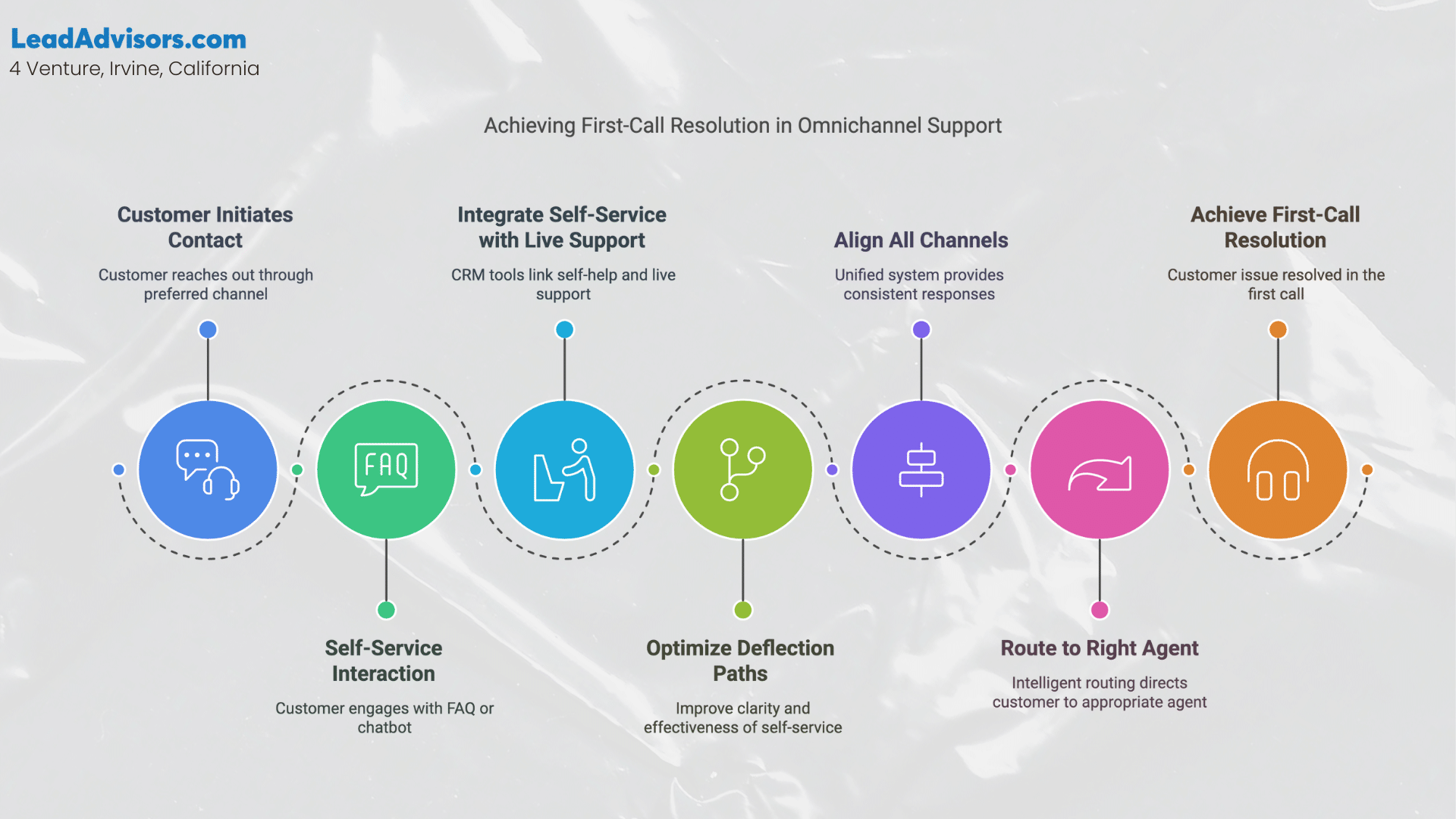
Today’s customers reach out on their terms—whether that’s by phone, chat, email, or social media. However, this flexibility introduces new challenges when it comes to first-call resolution (FCR).
Let’s break down the key considerations:
The Self-Service Paradox
If a customer visits your FAQ or interacts with a chatbot before calling, is that phone call truly their first contact? While many teams count the first live interaction as the “first call,” customers don’t separate self-service from live support, it’s all part of one experience.
Solution: Integrate self-help interactions with live agent records using tools like CRM platforms or QAcall. This gives you a fuller picture of the entire customer journey and more accurate FCR tracking.
Optimize Deflection Paths
Self-service is great, if it actually works. Confusing IVR menus, outdated help articles, or dead-end chatbots can frustrate customers and force them to reach out again, negatively impacting your first call resolution.
Solution: Build clear and effective knowledge hubs. Keep your content updated, streamline IVR flows, and ensure that every deflection point leads to resolution—not more confusion.
Align All Channels
Customers expect consistent service whether they contact you via chat, social, phone, or email. Disconnected systems often result in inconsistent answers and poor experiences.
Solution: Use contact center software that unifies all support channels. This allows agents to see the full history of customer interactions and respond with context, keeping your first call resolution goals intact.
Route to the Right Agent the First Time
Nothing derails FCR faster than a customer being transferred multiple times. Delays, repeated explanations, and frustration all pile up quickly.
Solution: Implement intelligent routing that uses skill-based or intent-based logic. Pair this with customer relationship management data to get the right issue to the right person, on the first try.
Omnichannel success isn’t about being everywhere, it’s about being consistent everywhere. And when your systems and strategy are aligned, first-call resolution becomes much easier to achieve across the board.
Advanced FCR Strategies for 2025
If your team has already covered the FCR basics, now’s the time to take it to the next level. These advanced strategies are designed to drive measurable improvements, reduce repeat contacts, and transform your support operations into a customer experience engine.
1. Leverage AI for Real-Time Agent Assist & Predictive Resolution
What to do:
Integrate AI tools that provide live call guidance,like recommended responses, product details, compliance reminders, or next-best actions—while the agent is speaking to the customer. Use predictive models to alert reps when a call is at risk of failing FCR (e.g., repeated keywords, negative sentiment, or hesitation).
How to implement:
- Use QAcall or similar software with real-time transcription and sentiment detection. AI is changing the support game—learn how artificial intelligence in call centers can enhance agent performance and customer satisfaction.
- Train agents to react quickly to AI-suggested prompts
- Track post-call outcomes to fine-tune predictive models
Impact:
Agents become faster and more confident at resolving complex issues, without escalations or repeat contacts.
2. Use Customer Journey Heatmaps to Identify High-Impact Call Drivers
What to do:
Map out the digital and human touchpoints customers go through before they contact your support team. Identify drop-off points, confusion zones, or high-friction steps that often lead to calls.
How to implement:
- Combine web analytics, IVR data, and contact center logs
- Categorize top call reasons (billing confusion, order issues, login problems)
- Align cross-functional teams to fix the root cause
Impact:
Fewer customers need to call in the first place, improving FCR by reducing the volume of avoidable contacts.
3. Run Verbatim Feedback Analysis to Spot Root Issues
What to do:
Go beyond satisfaction scores and dig into actual customer comments, both in post-call surveys and transcripts. Focus on words and phrases that indicate dissatisfaction, confusion, or unresolved needs.
How to implement:
- Automate transcript tagging and keyword tracking using tools like QAcall
- Review a weekly sample of calls flagged by sentiment score.
- Turn insights into knowledge base updates and agent training sessions.
Impact:
Uncovers the real reasons customers have to call back, helping you close knowledge and communication gaps.
4. Develop a Cross-Department FCR Operating Model
What to do:
FCR isn’t just the responsibility of the support team. Create an FCR framework that includes operations, product, billing, and marketing, any team whose work touches the customer.
How to implement:
- Define shared first call resolution goals and metrics across departments
- Align escalation paths so agents aren’t blocked by policy limit.s
- Host monthly FCR review meetings with key stakeholders
Impact:
Creates a culture where resolution is everyone’s job, resulting in faster, cleaner, and more consistent outcomes for customers.
Action Plan Template: Building Your FCR Strategy
Want to turn all this insight into real results? Here’s a practical framework to help you build or optimize your first call resolution (FCR) strategy, step by step.
Quick-Start Checklist
Use this as your launchpad. If you can check 80% or more, you’re already on the path to higher FCR.
- We’ve clearly defined what counts as a “first call resolution” internally
- All frontline agents are trained to confirm resolution before ending a call
- We track repeat contacts across all channels (not just phone)
- Our IVR or chatbot is optimized for correct routing and deflection
- We review FCR rates weekly by team and call driver
- Agents have access to real-time support tools (like AI or searchable KB)
- FCR improvement is tied to agent performance and recognition programs
- Different departments (not just support) are involved in root-cause fixes
- Our QA system (e.g., QAcall) provides compliance and sentiment scoring…
Make sure your QA efforts align with industry standards by following these call center quality assurance best practices. - Post-call surveys ask whether the customer’s issue was truly resolved
Key FCR Metrics to Track
Training, Tech & Process Alignment Matrix
This final matrix helps align your internal strategy across the three pillars of first-call resolution improvement.

With this action plan, you can move from reactive support to a resolution-first strategy, boosting FCR, cutting costs, and improving customer loyalty.
FAQs: First Call Resolution, Simplified
1. What is a good FCR rate to aim for?
2. Does a chat or email count as a ‘first call’?
3. Should repeat calls on different channels count against FCR?
4. How long should you wait to count an issue as resolved?
5. Can FCR improvement reduce operational costs?
Why FCR Should be Your North Star?
Improving First Call Resolution (FCR) isn’t just about reducing repeat calls—it’s about delivering a better, faster, more satisfying experience across the entire customer journey. High FCR drives stronger customer satisfaction, more efficient teams, and actual cost savings. And let’s face it: when customers only need to contact you once to get help, that’s when your support is truly working.
But FCR isn’t a “set it and forget it” metric. To keep performance high, it takes consistent measurement, cross-department collaboration, smart technology, and a culture of continuous improvement.
Whether you’re just starting out or refining a mature support operation, using the right tools (like QAcall), aligning your training and processes, and focusing on real customer outcomes will help you master FCR—and improve every other metric along the way.




